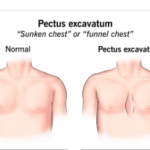Grover’s disease is one of those confusing skin disorders that frequently strikes without warning, particularly in elderly men who have been exposed to the sun for a long time or who have recently had health stressors. It can arise abruptly, cause intense itching, and then either go away or persist for months. This erratic nature makes the experience very frustrating for a lot of individuals.

The actual rash is surprisingly straightforward: little red pimples or vesicles dispersed around the back, chest, and sometimes upper arms. However, what appears to be a modest skin flare frequently conceals a more serious disturbance. Histologically, it shows acantholysis, or skin cell dissociation, sometimes accompanied by aberrant keratinization. Essentially, under certain triggers, the structure of the skin is momentarily disintegrating, and the ensuing itching can be extremely severe.
Grover’s Disease – Key Information (No Code Table)
| Category | Information |
|---|---|
| Medical Name | Transient Acantholytic Dermatosis |
| Common Name | Grover’s Disease |
| Typically Affects | Caucasian men over age 50 with sun-damaged or aged skin |
| Most Common Symptoms | Itchy, red papules and vesicles on chest, back, upper arms |
| Frequent Triggers | Sweating, heat, sun exposure, fever, prolonged bedrest, cancer treatment |
| Common Misdiagnoses | Eczema, folliculitis, heat rash, Darier disease |
| Confirmed Diagnosis | Clinical evaluation, confirmed by skin biopsy |
| Known Risk Associations | COVID-19, chemotherapy, BRAF-inhibitors, sun damage |
| Treatments | Topical steroids, moisturizers, oral retinoids, cryotherapy, phototherapy |
| Preventive Measures | Stay cool, wear breathable clothing, avoid sweat accumulation |
| Trusted Resource |
Doctors called it “transient” for decades, assuming it would go away soon. However, that word has turned out to be too hopeful. Numerous patients report repeated episodes, which are frequently brought on by fevers, heat waves, or excessive perspiration. Dermatologists have noticed a rise in Grover’s cases in the past few months, especially after COVID-19, which is caused by viral infections. In one instance, SARS-CoV-2 traces were found in the patient’s sweat glands, indicating a potential immunological response connection. This association adds a significant element to the developing narrative of Grover’s disease, even though it is not definitive.
Caucasian men over 50 are primarily affected by the condition, particularly those who have accumulated years of sun exposure. However, younger people receiving cancer treatment are now more likely to experience it. Grover-like skin eruptions have been closely associated with BRAF-inhibitors, such as dabrafenib and vemurafenib, which are used to treat metastatic melanoma. It’s interesting to note that these outbreaks seem to be considerably decreased when BRAF inhibitors and MEK inhibitors are combined, suggesting a possible beneficial interaction between therapies. Dermatological adverse effects in cancer patients have been significantly reduced by this clinical oncology change.
Despite its odd name, Grover’s disease has quietly becoming more well-known in high-performance circles. Actors and sportsmen in retirement frequently endure extended periods of perspiration, form-fitting clothes, and continuous exposure to intense lighting. Numerous unidentified performers have talked about their battles with persistent, enigmatic rashes that only improved with particular dermatological treatments. Grover’s disease may be more prevalent among aging celebrities than is generally recognized, according to anecdotal data from backstage crews and personal helpers, even if HIPAA prohibits definitive proof.
Instead of curing, treatment only addresses the symptoms. Topical steroids provide short-term relief for many. When used regularly, corticosteroid lotions or creams can dramatically reduce inflammation, which is why dermatologists frequently recommend them. Additionally helpful are moisturizing lotions that contain camphor or menthol, which have a cooling effect that reduces itching and stops additional skin deterioration. Systemic therapies such oral retinoids or phototherapy may be recommended for people with severe or persistent instances. By controlling the skin’s cell turnover, these treatments can lessen the likelihood that new lesions will reappear.
When a single lesion is unpleasant or deformable, some experimental techniques are employed, such as cryotherapy and trichloroacetic acid treatments. These therapies are usually applied expertly as a component of a more comprehensive dermatological approach. Crucially, as a first line of defense, many physicians now advise patients to take preventive action. Keeping cool, avoiding tight clothing, and keeping the skin dry during hot weather can significantly lessen flare-ups.
Lifestyle changes are another aspect of prevention. Patients in humid climates benefit greatly from fabrics that wick away moisture. To prevent extended exposure to perspiration, sauna users, gym patrons, and outdoor workers are encouraged to take frequent showers and change into dry clothes. Despite their apparent simplicity, these adjustments are very effective at reducing the frequency of flares.
The frequency of incorrect diagnoses for Grover’s sickness is an intriguing aspect of the condition. Patients frequently go through several therapies before being properly diagnosed because of clinical symptoms that resemble eczema, folliculitis, or even heat rash. In one case, a retired construction manager received misguided treatments for almost a year before a biopsy showed characteristic Grover’s histology. Following confirmation of the diagnosis, a customized regimen significantly improved his condition, enabling him to return to his usual activities without experiencing any discomfort.
The psychological effects of Grover’s disease add to the already significant burden for people who have underlying malignancy. Recovery may be hampered by the sense of powerlessness brought on by the outward deformity and constant itching. However, care teams are becoming more proactive in addressing such side effects early because to interdisciplinary cooperation, especially between dermatology and oncology.
Grover’s illness also draws attention to a blind spot in society: the propensity to minimize long-term, non-life-threatening illnesses. The idea that a rash is “just cosmetic” ignores the severe pain that some sufferers experience. Well-established consequences include disturbed sleep, social disengagement, and persistent concern over skin appearance. Clearer public education and more clinical knowledge are becoming more and more necessary as teledermatology expands and more patients turn to the internet for guidance.
The impact of destigmatization has already been demonstrated by public personalities who are open about their experiences with chronic skin illnesses, such as Selma Blair’s forthright conversations about her struggle with MS-related symptoms and Kim Kardashian’s open chats about psoriasis. As we’ve seen with other lesser-known conditions, a celebrity speaking out about Grover’s disease might spark a fresh wave of public support, money, and research interest.
Grover’s illness is gradually changing from a little-known anecdote to a disorder that represents a larger trend in dermatology, where environmental exposures, external stressors, and systemic health all come together at the skin. That change is a sign of hope. Targeted treatments that stop Grover’s at the molecular level may eventually result from new research into the MAP-kinase pathway, the same mechanism impacted by BRAF-inhibitors. Even though that day hasn’t arrived yet, the development is encouraging.





